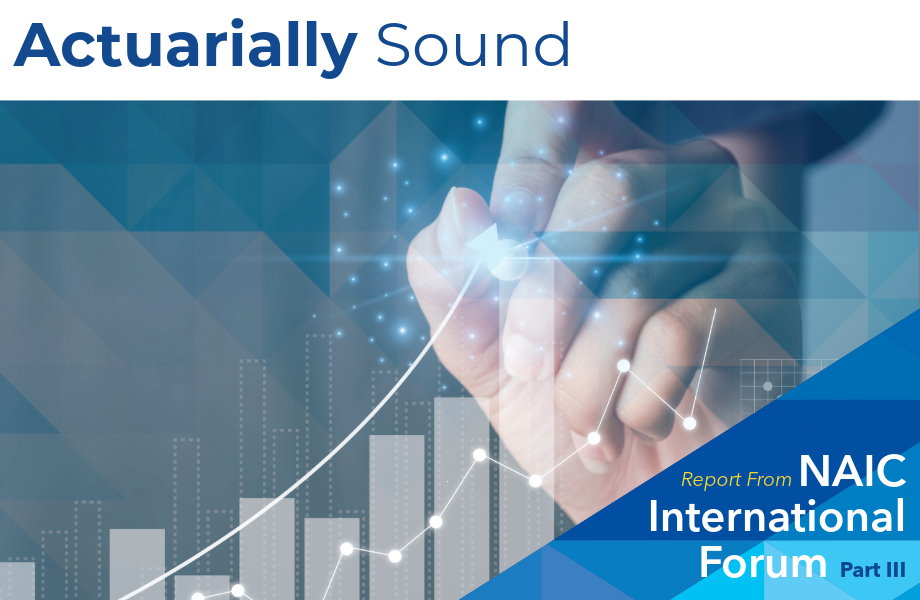
Part III Report From NAIC International Forum
By Will Behnke and Barbara Bryant
Academy Policy Staff
Third of a three-part series. Read part I and part II.
The world is evolving in unheralded ways and it’s hard to keep up with-much less adapt to-so many varied and far-reaching developments. How will the insurance industry be affected by rapidly emerging environmental, technology, economic and other trends? And how can or should the industry evolve to adapt to uncertainty on multiple fronts while continuing to serve the public? More than 250 industry experts gathered in Washington, D.C., during the NAIC’s 2025 International Insurance Forum in late May to explore these and many other questions. This three-part blog series highlights what the Academy identified as key issues during the keynote sessions and expert panel discussions.
Emerging Markets-Advancing Products and Technology
Panelists:
- Mimoza Kaçi, General Executive Director, Albanian Financial Supervisory Authority
- Ekhosuehi Iyahen, Secretary General, Insurance Development Forum
- Suzette Vogelsang, Senior Financial Sector Expert, International Monetary Fund (IMF)
Moderator:
- Justin Zimmerman, Co-Vice Chair, NAIC International Insurance Relations (G) Committee, and Commissioner, New Jersey Department of Banking and Insurance
Emerging markets refer to the provision of insurance by companies operating within developing or transitioning economies that are experiencing rapid growth and increasing integration into the global market. Considered by some to be too risky and underdeveloped, they are often overlooked. These markets present opportunities but also challenges for insurance companies, including a large and growing potential customer base, evolving regulatory landscapes, and specific risk profiles. Historically, emerging markets have been viewed as lagging behind established markets in insurance coverage and market penetration rates.
However, emerging markets also feature a rapidly expanding, mobile-first potential customer base, resulting in companies that are increasingly using a variety of customized products and online tools to attract customers. During their discussion, several examples of affordable microinsurance policies, such as index-based farmers’ insurance products that trigger payouts based on rainfall data or other metrics, as well as pay-as-you-go health and transportation insurance products, which are linked to consumer behavior or usage, were referenced. In Kenya, for example, mobile money (the ability to conduct non-bank-associated financial transactions through cell phones) is being leveraged to collect insurance premiums and distribute claims, while in Albania, insurance products are being integrated into digital banking apps.
Technology development is not limited to individual services in these emerging markets. Satellite imaging and remote sensing tools are being used to design agricultural index insurance. Artificial intelligence and big data analytics are also being incorporated into price risks, detect fraud, and reach untapped markets.
The conversation then focused on recommendations for regulators and policymakers, highlighting opportunities to offer support for the expansion of the insurance sector in developing countries. This included the introduction of flexible licensing systems and sandbox programs, which are controlled environments where companies can test new programs under regulatory supervision. Such flexibilities could help expedite the availability of non-traditional insurance offerings and encourage the development of public-private partnerships to support such efforts.
Governments can also pursue blended finance models, co-investment in risk pools, or public guarantees to extend insurance to underserved consumer groups. Some projects along these lines are already underway, including drought insurance developed in eastern and southern Africa by reinsurers and a collaboration between insurers, the World Bank, and governments to create sovereign pools that cover disaster risk in southeast Asia and the Caribbean. Other ways governments can be involved, as discussed by the panelists, include providing effective consumer education and supporting needs-based technology development. An example is the introduction of electronic consumer-identity verification systems, which could replace in-person identification methods.
Academy Engagement
Several Risk Management and Financial Reporting Council (RMFRC) committees monitor international developments and trends that affect insurance markets and the industry. There is also cross-practice interest in some of these issues, such as offshore reinsurance. There has been significant interest at the state regulatory level, particularly within the NAIC related to offshore reinsurance. The Life Practice Council published this February 2024 issue brief, Asset-Intensive Reinsurance Ceded Offshore from U.S. Life Insurers (with a focus on Bermuda), and also offered a presentation at the 2024 SOA ValAct Meeting. While the Academy remains primarily focused on public policy and the profession within the U.S., we monitor and selectively engage with our international partners on issues of common interest.